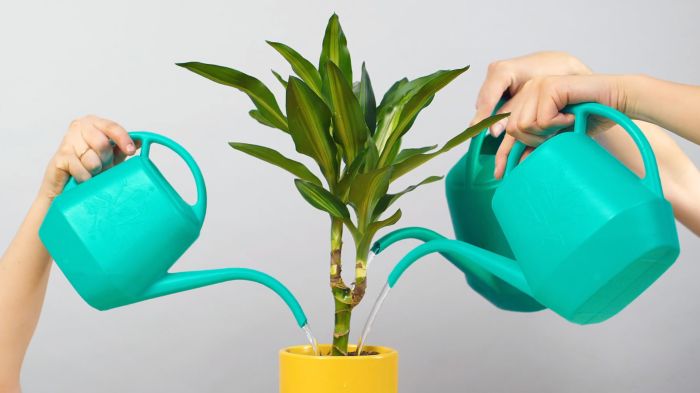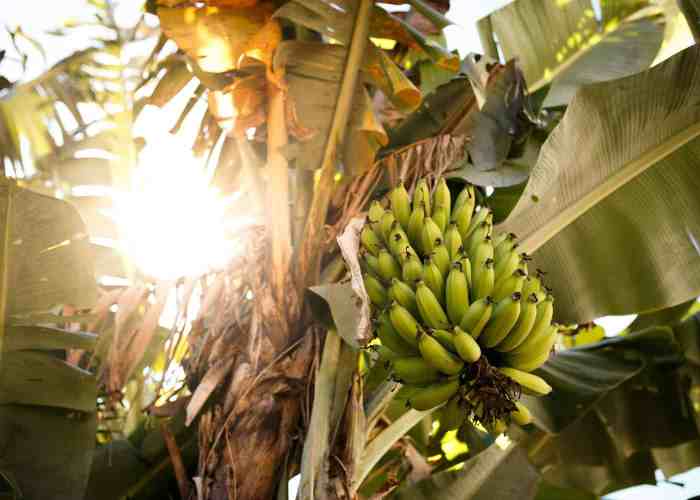How Much to Water Plants After Planting
Initial Watering After Planting
How much to water plants after planting – Proper initial watering is crucial for the successful establishment of newly planted specimens. A thorough watering immediately after planting helps settle the soil around the roots, reducing air pockets and promoting better contact between the roots and the surrounding medium. This, in turn, facilitates efficient water and nutrient uptake, leading to faster establishment and healthier growth.
Methods for Ensuring Proper Soil Saturation
Achieving proper soil saturation without overwatering requires a delicate balance. The goal is to thoroughly moisten the root zone without creating waterlogged conditions that can lead to root rot. This can be achieved through a combination of techniques.
- Soaking: Gently soak the soil around the plant until water begins to drain from the bottom of the planting hole or container. This ensures that the roots are thoroughly moistened.
- Slow and Steady Watering: Avoid using a forceful stream of water, which can erode the soil and damage delicate roots. Instead, apply water slowly and evenly, allowing it to penetrate the soil gradually.
- Mulching: Applying a layer of mulch after planting helps retain soil moisture, reducing the frequency of watering and minimizing water loss through evaporation.
Step-by-Step Guide for Watering Newly Planted Plants
The watering process varies slightly depending on the size and type of plant. However, the basic principles remain consistent.
- Seedlings: Gently water the soil around the seedlings using a fine mist or watering can with a rose attachment. Avoid directly spraying the delicate leaves.
- Saplings: Water deeply and slowly, ensuring that the water penetrates the entire root ball. Check the soil moisture regularly, and water again when the top inch or two feels dry.
- Established Plants: Water deeply and less frequently, allowing the soil to dry slightly between waterings. The watering frequency will depend on the plant type, soil type, and weather conditions.
Watering Techniques Comparison
Different plant types have different watering requirements. The following table provides a comparison of suitable watering techniques for various plant categories.
| Plant Type | Watering Technique | Frequency | Considerations |
|---|---|---|---|
| Succulents | Bottom watering, infrequent deep watering | Once every 1-2 weeks, or when soil is completely dry | Avoid overhead watering to prevent rot |
| Herbs | Top watering, consistent moisture | Every 2-3 days, or when the top inch of soil feels dry | Ensure good drainage to prevent waterlogging |
| Vegetables | Top watering, deep and infrequent | Every 2-3 days, or when the top inch of soil feels dry, adjusting based on weather | Water deeply to encourage root growth |
| Roses | Deep watering at the base of the plant | Once or twice a week, or when the top inch of soil feels dry, depending on weather | Avoid wetting foliage to prevent fungal diseases |
Watering Frequency Based on Plant Type
The frequency of watering varies significantly depending on the plant’s water requirements. Drought-tolerant plants can withstand longer periods without water, while others require frequent watering to maintain optimal health.
Plant Water Requirement Examples
Here are some examples of plants with varying water needs:
- High Water Requirements: Lettuce, Basil, Tomatoes, Hydrangeas
- Medium Water Requirements: Roses, Lavender, Daylilies, Peppers
- Low Water Requirements: Sedum, Cactus, Aloe Vera, Oregano
Signs of Underwatering and Overwatering, How much to water plants after planting
Recognizing the signs of underwatering and overwatering is essential for maintaining plant health. Symptoms can vary depending on the plant type but generally include:
- Underwatering: Wilting leaves, dry soil, stunted growth, leaf browning or crisping.
- Overwatering: Yellowing leaves, soggy soil, root rot (indicated by foul odor and mushy roots), leaf drop.
Ideal Watering Schedules

Source: sanity.io
The following is a general guide to ideal watering schedules. Remember that these are just guidelines, and the actual frequency may vary depending on specific conditions.
- Daily Watering: Many seedlings, newly planted specimens in hot, dry climates.
- Every Other Day: Some herbs, vegetables, and flowering plants in warm weather.
- Weekly Watering: Many established plants, drought-tolerant species, and plants in containers with good drainage and moisture-retentive soil.
Factors Affecting Watering Needs
Several factors influence a plant’s water requirements, making it crucial to consider these variables when developing a watering schedule.
Impact of Soil Type
Sandy soils drain quickly, requiring more frequent watering than clay soils, which retain moisture longer. Well-draining soil is generally preferred to prevent waterlogging.
Role of Weather Conditions
Hot, sunny, and windy conditions increase evaporation rates, necessitating more frequent watering. Rainfall should be factored into the watering schedule; reduce watering on days with significant rainfall.
Influence of Pot Size and Material
Smaller pots dry out faster than larger ones. Terracotta pots are porous and allow for greater evaporation than plastic or glazed ceramic pots.
Effects of Plant Maturity
Mature plants with well-established root systems often require less frequent watering than younger plants with smaller root systems.
Practical Watering Techniques
Different watering methods offer varying degrees of efficiency and control. Selecting the appropriate technique depends on factors such as the size of the garden, the type of plants, and available resources.
Watering Methods

Source: homefortheharvest.com
- Top Watering: Applying water directly to the soil surface. Simple and effective for most plants but can lead to soil compaction if done improperly.
- Bottom Watering: Soaking the plant pot in a tray of water, allowing the plant to absorb water from the bottom up. This is particularly beneficial for plants susceptible to fungal diseases.
- Drip Irrigation: A system of tubes and emitters that delivers water directly to the roots. This method conserves water and minimizes water loss through evaporation.
Setting Up a Simple Drip Irrigation System
- Purchase a drip irrigation kit.
- Lay out the tubing according to your plant layout.
- Connect the emitters to the tubing and place them near the base of each plant.
- Connect the tubing to a water source.
- Turn on the water and adjust the flow rate as needed.
Water Conservation Tips
- Water deeply and less frequently.
- Water in the early morning or late evening to reduce evaporation.
- Use mulch to retain soil moisture.
- Collect rainwater for irrigation.
Ideal Water Absorption Pattern
Imagine a cross-section of the soil around a plant’s root system. Water should penetrate deeply and evenly, creating a moist sphere around the roots, extending beyond the immediate vicinity of the plant’s stem. The outer edges of this sphere should be gradually less moist, preventing waterlogging while ensuring sufficient moisture availability to the roots. This pattern optimizes water absorption and minimizes runoff or evaporation.
Troubleshooting Watering Issues: How Much To Water Plants After Planting
Improper watering can lead to various plant problems. Recognizing the symptoms and addressing the underlying cause is critical for restoring plant health.
Troubleshooting Guide
| Problem | Cause | Solution | Prevention |
|---|---|---|---|
| Wilting | Underwatering, heat stress | Water deeply and thoroughly; provide shade during peak heat | Consistent watering, mulching |
| Yellowing Leaves | Overwatering, nutrient deficiency | Adjust watering frequency; conduct soil test and amend as needed | Proper watering practices, regular fertilization |
| Root Rot | Overwatering, poor drainage | Repot in well-draining soil; remove affected roots | Ensure good drainage, avoid overwatering |
| Stunted Growth | Underwatering, nutrient deficiency | Water deeply; fertilize appropriately | Regular watering and fertilization |
User Queries
How often should I water newly planted trees?
Newly planted trees typically need regular watering, especially during dry spells. Aim for deep, infrequent watering rather than shallow, frequent watering to encourage deep root growth. The frequency will depend on factors such as tree species, soil type, and weather conditions.
What are the signs of overwatering?
Proper watering after planting is crucial for establishing new roots. The initial watering should thoroughly soak the soil, encouraging root development. The frequency then depends on the plant; for instance, finding the right balance is key, as seen in this guide on how many times to water jade plant. Ultimately, consistent moisture, but not overwatering, is the goal for healthy growth after transplanting.
Signs of overwatering include yellowing or browning leaves, wilting (even with moist soil), and a foul odor emanating from the soil. The plant may also exhibit stunted growth.
Can I use tap water to water my plants?
Generally, tap water is acceptable, but it’s best to let it sit out for 24 hours to allow chlorine to dissipate. High levels of chlorine or fluoride can harm some plants.
My plant’s leaves are drooping. Is it underwatered or overwatered?
Drooping leaves can indicate both under and overwatering. Check the soil moisture; if it’s dry, it’s likely underwatered. If it’s soggy, it’s likely overwatered.





















